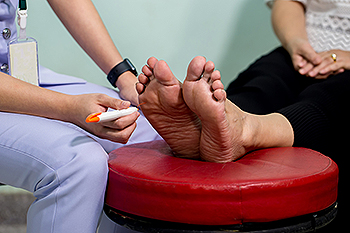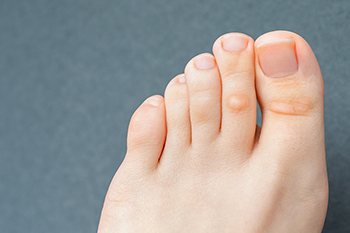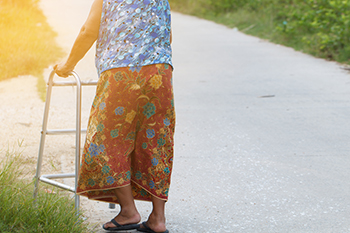Baytown, TX (281) 837-8371
March 2022
Feet are Affected with Diabetes
 People who are diabetic are often concerned about the health of their feet. Elevated blood sugar levels in diabetic patients may lead to possible nerve damage, foot ulcers, and foot deformities. It is important for patients to examine their feet daily, and notice any cuts, bruises, or broken skin. Additionally, it is beneficial to take extra time and care while trimming the toenails, and it helps to wear shoes and socks that fit correctly. Research has indicated that diabetic patients who refrain from walking barefoot can have fewer foot injuries. If you have diabetes, it is strongly suggested that you be under the care of a podiatrist who can correctly monitor this condition.
People who are diabetic are often concerned about the health of their feet. Elevated blood sugar levels in diabetic patients may lead to possible nerve damage, foot ulcers, and foot deformities. It is important for patients to examine their feet daily, and notice any cuts, bruises, or broken skin. Additionally, it is beneficial to take extra time and care while trimming the toenails, and it helps to wear shoes and socks that fit correctly. Research has indicated that diabetic patients who refrain from walking barefoot can have fewer foot injuries. If you have diabetes, it is strongly suggested that you be under the care of a podiatrist who can correctly monitor this condition.
Diabetic foot care is important in preventing foot ailments such as ulcers. If you are suffering from diabetes or have any other concerns about your feet, contact Abeer M. Foteh, DPM from Greater Houston Foot Centers. Our doctor can provide the care you need to keep you pain-free and on your feet.
Diabetic Foot Care
Diabetes affects millions of people every year. The condition can damage blood vessels in many parts of the body, especially the feet. Because of this, taking care of your feet is essential if you have diabetes, and having a podiatrist help monitor your foot health is highly recommended.
The Importance of Caring for Your Feet
- Routinely inspect your feet for bruises or sores.
- Wear socks that fit your feet comfortably.
- Wear comfortable shoes that provide adequate support.
Patients with diabetes should have their doctor monitor their blood levels, as blood sugar levels play such a huge role in diabetic care. Monitoring these levels on a regular basis is highly advised.
It is always best to inform your healthcare professional of any concerns you may have regarding your feet, especially for diabetic patients. Early treatment and routine foot examinations are keys to maintaining proper health, especially because severe complications can arise if proper treatment is not applied.
If you have any questions please feel free to contact our office located in Baytown, TX . We offer the newest diagnostic and treatment technologies for all your foot and ankle needs.
Teen Athletes Are Prone to Sever’s Disease
When your child is between 9 and 14 years old, the growth plate of the cartilage in the heel may not match the growth of the heel bone itself. This imbalance may cause a condition known as Sever’s disease, common in youngsters who play sports or are otherwise physically active. Luckily, it’s not actually a disease and will eventually subside as the child matures. Symptoms include swelling, stiffness in the feet, limping or walking on tiptoe, and pain in the heel. The main thing to do is stop the activity that may be at the root of the condition, especially if it calls for continued running and jumping on hard surfaces. Usually, low impact activities like swimming are not a problem. Sever’s disease generally subsides when the heel plate finishes growing, around the age of 15. If your younger teenage children are involved in sports, it is a good idea to introduce them to a podiatrist who can do regular examinations and treat any foot care problems as they arise.
Sever's disease often occurs in children and teens. If your child is experiencing foot or ankle pain, see Abeer M. Foteh, DPM from Greater Houston Foot Centers. Our doctor can treat your child’s foot and ankle needs.
Sever’s Disease
Sever’s disease is also known as calcaneal apophysitis, which is a medical condition that causes heel pain I none or both feet. The disease is known to affect children between the ages of 8 and 14.
Sever’s disease occurs when part of the child’s heel known as the growth plate (calcaneal epiphysis) is attached to the Achilles tendon. This area can suffer injury when the muscles and tendons of the growing foot do not keep pace with bone growth. Therefore, the constant pain which one experiences at the back of the heel will make the child unable to put any weight on the heel. The child is then forced to walk on their toes.
Symptoms
Acute pain – Pain associated with Sever’s disease is usually felt in the heel when the child engages in physical activity such as walking, jumping and or running.
Highly active – Children who are very active are among the most susceptible in experiencing Sever’s disease, because of the stress and tension placed on their feet.
If you have any questions, please feel free to contact our office located in Baytown, TX . We offer the newest diagnostic and treatment technologies for all your foot and ankle injuries.
How Rheumatoid Arthritis Can Affect the Toes
 Anyone with rheumatoid arthritis (RA) knows the inflammatory joint pain, stiffness, and swelling that can become a constant factor in their life. About a fifth of people with RA experience this inflammation first in one of the many toes, foot, and ankle joints. As this chronic disease gets worse, it brings with it damage to ligaments and other tissues surrounding the joints. Among the effects are hammertoe, where the middle joint of the toe bends upward; bunions, where the bone on the big toe protrudes as it is displaced; bursitis, where the fluid-filled sacs in a joint become inflamed; and claw toe, where the toe curls under. Because there is no known cure for rheumatoid arthritis, it is especially important to seek the care of a podiatrist who can help to identify the severity of the affected area(s) and begin a course of treatment to reduce the pain through medication, lifestyle changes, and possibly surgery if needed.
Anyone with rheumatoid arthritis (RA) knows the inflammatory joint pain, stiffness, and swelling that can become a constant factor in their life. About a fifth of people with RA experience this inflammation first in one of the many toes, foot, and ankle joints. As this chronic disease gets worse, it brings with it damage to ligaments and other tissues surrounding the joints. Among the effects are hammertoe, where the middle joint of the toe bends upward; bunions, where the bone on the big toe protrudes as it is displaced; bursitis, where the fluid-filled sacs in a joint become inflamed; and claw toe, where the toe curls under. Because there is no known cure for rheumatoid arthritis, it is especially important to seek the care of a podiatrist who can help to identify the severity of the affected area(s) and begin a course of treatment to reduce the pain through medication, lifestyle changes, and possibly surgery if needed.
Because RA affects more than just your joints, including the joints in your feet and ankles, it is important to seek early diagnosis from your podiatrist if you feel like the pain in your feet might be caused by RA. For more information, contact Abeer M. Foteh, DPM of Greater Houston Foot Centers. Our doctor will assist you with all of your podiatric concerns.
What Is Rheumatoid Arthritis?
Rheumatoid Arthritis (RA) is an autoimmune disorder in which the body’s own immune system attacks the membranes surrounding the joints. Inflammation of the lining and eventually the destruction of the joint’s cartilage and bone occur, causing severe pain and immobility.
Rheumatoid Arthritis of the Feet
Although RA usually attacks multiple bones and joints throughout the entire body, almost 90 percent of cases result in pain in the foot or ankle area.
Symptoms
- Swelling and pain in the feet
- Stiffness in the feet
- Pain on the ball or sole of feet
- Joint shift and deformation
Diagnosis
Quick diagnosis of RA in the feet is important so that the podiatrist can treat the area effectively. Your doctor will ask you about your medical history, occupation, and lifestyle to determine the origin of the condition. Rheumatoid Factor tests help to determine if someone is affected by the disease.
If you have any questions please feel free to contact our office located in Baytown, TX . We offer the newest diagnostic and treatment technologies for all your foot and ankle needs.
Why Live with Pain and Numbness in Your Feet?
Corns Can Be In Two Places on the Foot
 Pain can often accompany a corn on the foot. A hard corn is defined as a small, toughened area that develops on top of the toes. It generally forms due to wearing shoes that do not fit correctly. The shoes may be too tight, and this can cause friction as the toes rub against the top of the shoes. A soft corn forms between the toes and is generally moist a majority of the time. Mild relief may be found when a protective covering is worn on top of the corn, or in between the toes. This can help to cushion and protect the corn as daily activities are completed. It is suggested to refrain from wearing high heels with an existing corn, in addition to limiting the amount of walking. If you have developed a corn, please speak to a podiatrist who can recommend proper removal techniques.
Pain can often accompany a corn on the foot. A hard corn is defined as a small, toughened area that develops on top of the toes. It generally forms due to wearing shoes that do not fit correctly. The shoes may be too tight, and this can cause friction as the toes rub against the top of the shoes. A soft corn forms between the toes and is generally moist a majority of the time. Mild relief may be found when a protective covering is worn on top of the corn, or in between the toes. This can help to cushion and protect the corn as daily activities are completed. It is suggested to refrain from wearing high heels with an existing corn, in addition to limiting the amount of walking. If you have developed a corn, please speak to a podiatrist who can recommend proper removal techniques.
Corns can make walking very painful and should be treated immediately. If you have questions regarding your feet and ankles, contact Abeer M. Foteh, DPM of Greater Houston Foot Centers. Our doctor will treat your foot and ankle needs.
Corns: What Are They? And How Do You Get Rid of Them?
Corns are thickened areas on the skin that can become painful. They are caused by excessive pressure and friction on the skin. Corns press into the deeper layers of the skin and are usually round in shape.
Ways to Prevent Corns
There are many ways to get rid of painful corns such as:
- Wearing properly fitting shoes that have been measured by a professional
- Wearing shoes that are not sharply pointed or have high heels
- Wearing only shoes that offer support
Treating Corns
Although most corns slowly disappear when the friction or pressure stops, this isn’t always the case. Consult with your podiatrist to determine the best treatment option for your case of corns.
If you have any questions please feel free to contact our office located in Baytown, TX . We offer the newest diagnostic and treatment technologies for all your foot and ankle needs.
Strong Bones and Falling
 Falling is known to be a common cause of injury in elderly people. This may be a result of weakened bones as the aging process evolves and can cause discomfort and stress. Many patients have developed a habit of walking daily, and bones may be strengthened by performing leg exercises. Additionally, it can help to get regular physical and eye examinations, and this can aid in preventing falling. There are preventative methods that can be implemented in the household that can lessen the number of falls. These include removing worn rugs, improving lighting, and using a shower mat in the bathroom. It is suggested that shoes with non-slip soles are worn, in addition to using a cane or walker, if needed. The feet may be affected by falling, and a fractured foot is not uncommon. If you would like to learn about how to prevent falling, please speak with a podiatrist who can answer any questions you may have.
Falling is known to be a common cause of injury in elderly people. This may be a result of weakened bones as the aging process evolves and can cause discomfort and stress. Many patients have developed a habit of walking daily, and bones may be strengthened by performing leg exercises. Additionally, it can help to get regular physical and eye examinations, and this can aid in preventing falling. There are preventative methods that can be implemented in the household that can lessen the number of falls. These include removing worn rugs, improving lighting, and using a shower mat in the bathroom. It is suggested that shoes with non-slip soles are worn, in addition to using a cane or walker, if needed. The feet may be affected by falling, and a fractured foot is not uncommon. If you would like to learn about how to prevent falling, please speak with a podiatrist who can answer any questions you may have.
Preventing falls among the elderly is very important. If you are older and have fallen or fear that you are prone to falling, consult with Abeer M. Foteh, DPM from Greater Houston Foot Centers. Our doctor will assess your condition and provide you with quality advice and care.
Every 11 seconds, an elderly American is being treated in an emergency room for a fall related injury. Falls are the leading cause of head and hip injuries for those 65 and older. Due to decreases in strength, balance, senses, and lack of awareness, elderly persons are very susceptible to falling. Thankfully, there are a number of things older persons can do to prevent falls.
How to Prevent Falls
Some effective methods that older persons can do to prevent falls include:
- Enrolling in strength and balance exercise program to increase balance and strength
- Periodically having your sight and hearing checked
- Discuss any medications you have with a doctor to see if it increases the risk of falling
- Clearing the house of falling hazards and installing devices like grab bars and railings
- Utilizing a walker or cane
- Wearing shoes that provide good support and cushioning
- Talking to family members about falling and increasing awareness
Falling can be a traumatic and embarrassing experience for elderly persons; this can make them less willing to leave the house, and less willing to talk to someone about their fears of falling. Doing such things, however, will increase the likelihood of tripping or losing one’s balance. Knowing the causes of falling and how to prevent them is the best way to mitigate the risk of serious injury.
If you have any questions, please feel free to contact our office located in Baytown, TX . We offer the newest diagnostic and treatment technologies for all your foot care needs.









